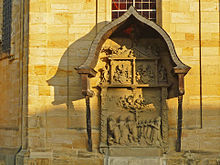Hans Werner (sculptor)
Hans Werner (* around 1560 in Mechenried ; † 1623 in Nuremberg ) was a baroque sculptor .
Life
His date of birth is unknown. According to a self-portrait on the grave monument of Georg Groß in Forchheim from 1590, it can be assumed that he was born around 1560. He was mainly active in the Franconian and Württemberg region. He died in Nuremberg in 1623.
Werner first worked in Bamberg for the prince-bishop's court, then went to Nuremberg in 1600, where he mainly worked for wealthy patricians . So around 1606 he created four magnificent chimneys in the Pellerhaus , which were unfortunately destroyed in the Second World War.
job
Werner liked to use fine-grained sandstones , which depicted the details of his ornamentation with sharp edges. In addition, he used coarse-grained, gray or red sandstones, but also alabaster , gray-white and red marble , limestone and agates for inlay work. Many of his epitaphs consist of combinations of materials. He aimed at polychromy by choosing different materials and only worked in a very reduced manner with color versions (partially black and gold). He signed his works in full name or with the abbreviation HW. He also liked to depict himself on it: So he formed himself on the epitaph of the tavern Johann III. in the chapel Schmiedelfeld in a sitting position with Knüpfel from.
Works (selection)

- Tomb of the Bamberg prince-bishop Johann Georg I. Zobel von Giebelstadt , around 1577/80, in the Bamberg monastery Michelsberg
- Epitaph of Otto Erhard von Mengersdorf at the pilgrimage church in Gößweinstein , 1588 (donated by his son, Bishop Ernst von Mengersdorf )
- Grave monument of Georg Groß in St. Martin's Church in Forchheim , 1590
- Tomb of the Bamberg prince-bishop Ernst von Mengersdorf († October 21, 1591) in Bamberg, completed in 1596, today in the Michelsberg monastery
- Tomb, dated somewhat later, of Hieronymus Kreß in the parish church of Nürnberg-Kraftshof
- “Scheurlsche Bettstatt” (Nuremberg) from 1601 with its lavish decoration made of ebony, black-stained pearwood and alabaster. The sculptures have been considered the work of Hans Werner since 1942 by the art historian Fritz Traugott Schulz .
- Epitaph of the donation Johann III. and his wife Eleonora , Schlosskapelle Schmiedelfeld, 1603
- Larger than life lying Bacchus made of sandstone on the portal of the wine cellar in the barracks courtyard of the Plassenburg in Kulmbach, 1605
- Portal of the high bastion of the former Hohenzollern fortress Plassenburg , 1607
- Coronation of the portal of the Teutonic Order of Nuremberg , 1609
Remarks
- ↑ It is not clear whether he is identical with the sculptor Hans von Wemding.
literature
- Felix Ettinghausen: Hans Werner, a Franconian sculptor around 1600 , Diss. Ms., Würzburg, 1921
- Johannes Hammn: A portal crowning the Nuremberg Teutonic Order House , in cultural property: From the research of the Germanisches Nationalmuseum , 4th quarter 2007, issue 15, pp. 1–4
- Silke Günther: The epitaph of the gift Johann and his wife Eleonora , unpublished. Diploma thesis, Department of Restoration, University of Applied Sciences Erfurt, 1999
Web links
| personal data | |
|---|---|
| SURNAME | Werner, Hans |
| BRIEF DESCRIPTION | German sculptor |
| DATE OF BIRTH | around 1560 |
| PLACE OF BIRTH | Mechenried |
| DATE OF DEATH | 1623 |
| Place of death | Nuremberg |
